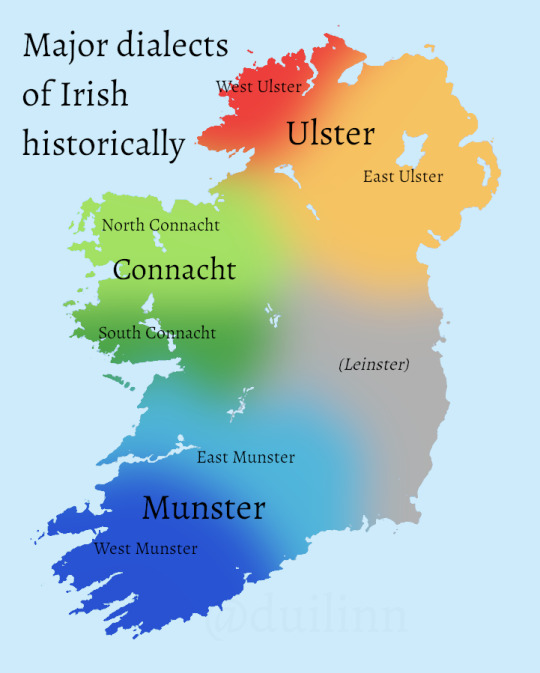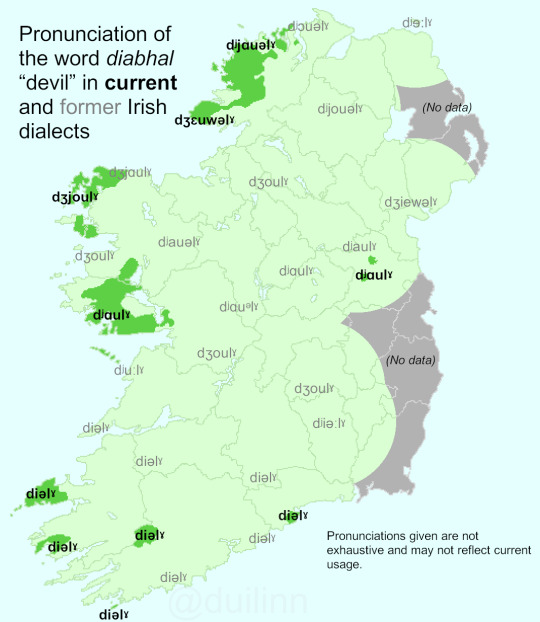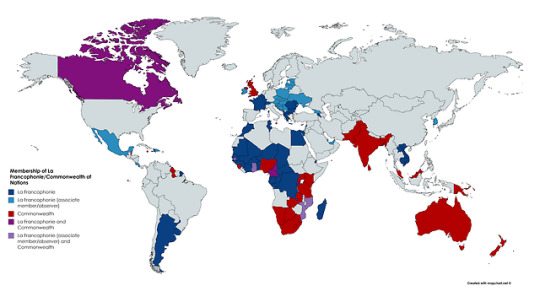#dublin2001
Photo

Historical distribution of Irish dialects.
by dublin2001
This is a rough guide as to the main historical dialects in Irish. Roughly this corresponds to 3 out of the 4 provinces of Ireland - Ulster, Connacht and Munster. Each of these is split in two, this seems to be the most common thing done in Irish linguistics.
I marked most of Leinster in grey (those parts that didn't speak Ulster or Munster Irish), this doesn't mean that it never spoke Irish, but that it is not usually included in classifications of dialects as Irish became extinct there first.
This map doesn't include more local details such as Ulster influence in parts of County Mayo, or the current Irish speaking areas in County Meath (or indeed "Connemara" or "West Kerry" - those are all historically part of much larger dialect groups). I previously made a pointlessly detailed map of Irish dialects a number of years ago, but I wanted something much simpler and less prone to errors.
This map only deals with the choice of dialect for a given area, and doesn't mean that the area in question spoke only Irish.
320 notes
·
View notes
Text
Unearthing Leinster Irish
There were three dialects in Leinster, Oriel/Meath, Ossory and Leinster Proper. Oriel/Meath was likened to East Ulster, while Ossory was very much like East Munster with a good few quirks from Connacht and Oriel.
Leinster Proper was said to be a mix of both, although it leaned more towards Munster. Most of this evidence had to be gathered from looking at the anglicisation of place names and a few pieces of writing.
This particular post focuses on Wicklow Irish, a part of (or rather, very much the centre) the Leinster dialect. Of course, as with the rest of the Leinster dialect, not much is known.
Sounds
-adh, -amh and -abh: In Wicklow, South Dublin and Offaly (possibly more, including Kildare), suffixes -adh, -amh and -abh were most likely -a as in sofa.
-dh: some parts of Leinster also pronounced -dh endings like 'v', similar to certain parts of Munster (and Scottish).
Slender bh and mh were silent: sléibhe pronounced as though slé (similar to Kerry Irish), though talamh being broad, still rendered as though written tala.
North of this area, these sounds formed -ú (as in Ulster).
Southeast of this area they were pronounced the same as in Kilkenny, Laois and Munster:
-amh = -av
-adh in nouns = -a
-adh in past tense = -ag
-igh, -aigh: As in the rest of Old Leinster, -igh was probably pronounced -e and -aigh was probably pronounced -a in Wicklow. Dublin Irish believes that in Wicklow and Dublin, these two sounds had in fact become identical to the -a above, the implication of which leads to -adh, -amh, -abh, -igh and -aigh all having been pronounced as -a in Old Leinster.
-gh: Words ending -gh were likely pronounced like 'y' in English.
-cn, -gn: Most of Ireland pronounces prefixes cn- and gn- in words such as cnoc and gnóthach as if cr- and gr- due to a change that took place in the 13th century. This can be seen in the placenames Crooksling (Cnoc Slinne) in Co. Dublin and Crukeen (Cnoicín) in Carlow.
Almost everywhere north of a line from Clare (where both forms were used) to South Kilkenny, cr- was the norm. South of this line, in parts of Clare, West Kilkenny and all of Munster, cn- and gn- remained cn-.
In Wicklow, being above this line, cn- and gn- were nearly always heard as cr- and gn-.
-ao- is pronounced either í as in Connacht, a close back unrounded vowel in parts of Donegal, or é as in Kilkenny, Laois and Munster. In Wicklow and South Dublin, the pronunciation followed the Munster é:
gaoth = gaéh
-ch, -cht: While two sources claim that the ch in -cht was silent, there is no conclusive evidence on this. Instead, there is evidence that both -ch and -cht were fully pronounced, as they were everywhere outside Ulster and Louth.
-th might have been pronounced as -ch, as in parts of Wexford, Kilkenny and Laois.
-bh- and -mh- are typically deleted and the preceding vowel lengthened. This would be the same in Munster, Kilkenny and Laois.
leabhar = leár
Gaeilge seemed to have been pronounced similar to Ulster in that it was said like Gaelag.
cad: Wicklow Irish used g- interrogatives
cad = goid / gad
Records show the mixed form goidé an chaoi athá tú from Carlow to the south east of Wicklow. Dublin used goid and gad. From this, we know that Wicklow was surrounded to its west and north by g-forms and therefore almost certainly used it too. North Kilkenny also has goidé.
Duanaire Osraíoch by Dáithí Ó hÓgáin: Collection of poems from Co. Kilkenny between 1750 to 1850; reflects nuances remarkably similar to that of Ulster Irish.
The Last native speaker of Louth dialect recorded
Reddit user u/dublin2001's research: Here is how Irish was spoken in Co. Dublin
0 notes
Photo

Pronunciation of "devil" in Irish dialects (past and present).
by u/dublin2001
Sources
Most locations:
Wagner, H., & McKendry, E. (1958). Linguistic atlas and survey of Irish dialects: V. 1. Dublin Institute for Advanced Studies.
Ráth Chairn (Irish speaking area in the east formed by settlers from the west in the 1930s):
STENSON, N. & Ó CIARDHA, P. (1986). The Irish of Ráth Cairn – A Supplement to ‘Linguistic Atlas and Survey of Irish Dialects’ (Part 1). , 41(1), 66-115. https://doi.org/10.1515/zcph.1986.41.1.66
Meath (original dialect, before Ráth Chairn):
Williams, N.J. (1970). Téacsanna Foghrúla ó Chontae na Mí. Studia Hibernica: Volume 31, Issue 1.
Laois:
Ó CONCHUBHAIR, (Donnchadh) (comp.): Focail Ghaedhilge ó Dharmhagh Ua nDuach. In Éigse 5, 1945/47 (1948), (pt. 4), pp. 267–82.
Westmeath:
MAC AN FHAILIGH, (Éamonn) (comp.): A Westmeath word-list. In Éigse 5, 1945/47 (1948), (pt. 4), pp. 256–66; 11, 1964/66, p. 245 [corrigenda].
Limerick:
BREATHNACH, (Nioclás) (comp.): Focail Ghaedhilge atá le clos sa Bhéarla a labhartar sa Chaisleán Nua, Co. Luimnigh. In Éigse 5, 1945/47 (1948), pp. 203–8; 6, 1948/52, pp. 169–79; 7, 1953/55, pp. 47–51.
150 notes
·
View notes
Photo

Membership of La Francophonie/Commonwealth of Nations.
by dublin2001:
Argentina and Uruguay should be light blue, my bad.
127 notes
·
View notes